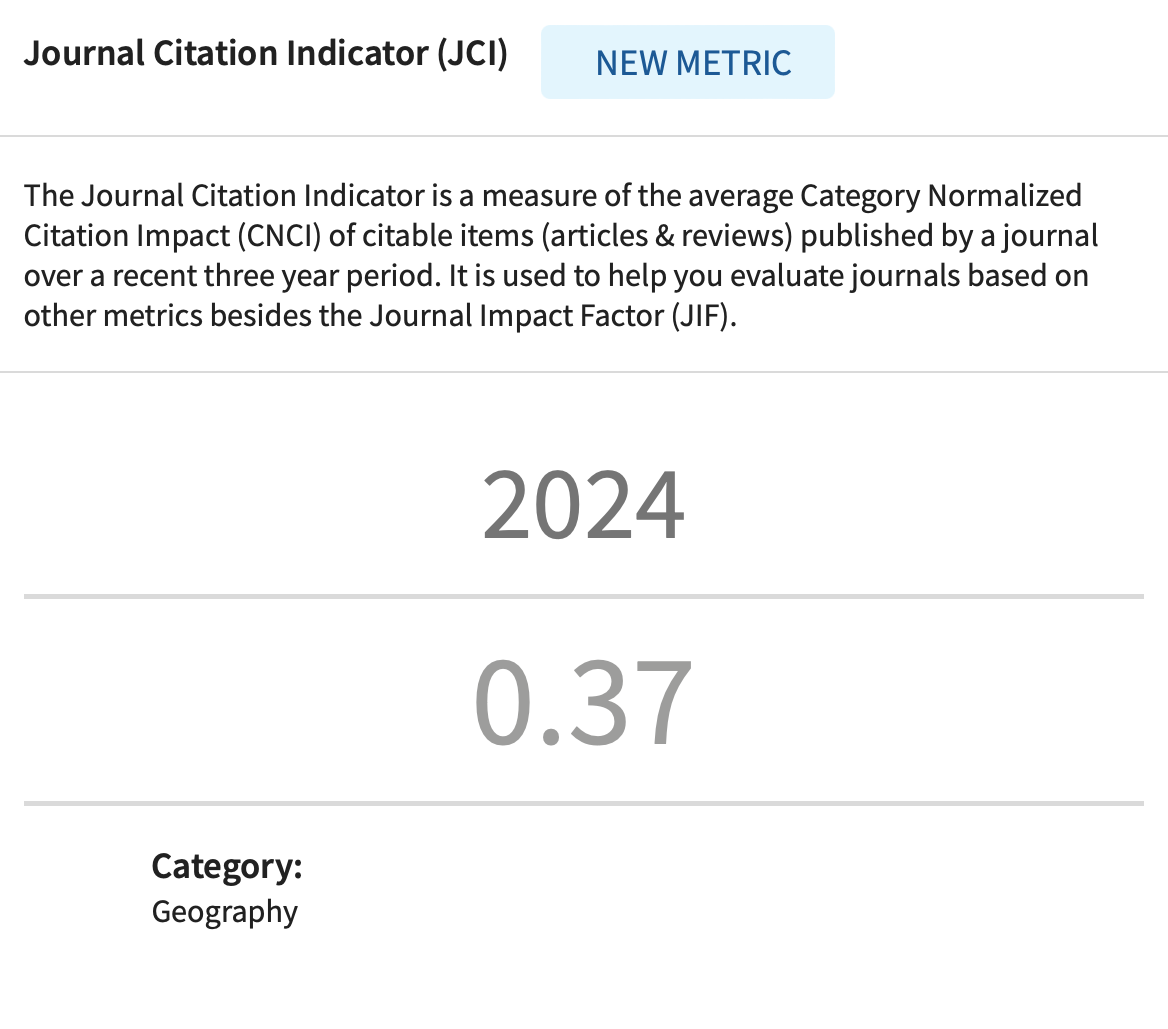TRANSFORMING SLUMS INTO SUSTAINABLE TOURISM DESTINATIONS ON THE COAST OF MAKASSAR CITY, INDONESIA
DOI:
https://doi.org/10.2298/IJGI250111014GKeywords:
settlements, slums, attractions, destinations, slum tourismAbstract
This study proposes a model for slum area development in Indonesia, focusing on the management of local potential and land suitability for tourism planning. Its main objectives are to identify local potentials in slum areas and to analyze land suitability for destination development. A quantitative descriptive approach was applied in this research, which was conducted in Tallo Village, Makassar City, selected for its comprehensive socio-economic, physical, and tourism-related data. Geographic mapping through Geographic Information Systems (GIS) aids the descriptive analysis. The findings suggest that the slum area in Tallo Village has strong potential to be developed into a community-based tourism destination with three key attractions: local cultural heritage, culinary experiences, and natural scenery. Integrating these elements could lead to the creation of a sustainable tourism destination that also enhances community welfare. The development model emphasizes strengthening local culture, culinary, and natural resources, aiming to positively impact the economy, boost local pride, and enhance the tourist experience. The analysis shows that the slum area is suitable for tourism development, with many parts falling into the suitable and very suitable categories. The study advocates for an integrative tourism development approach that incorporates environmental sustainability and local community involvement. It stresses that management practices that consider environmental carrying capacity and provide direct benefits to the local community are essential for ensuring the long-term sustainability of tourism in slum areas.
Article metrics
References
Aras, D. (2022). Strategy for Handling Fishermen’s Slums in Galesong, Takalar Regency Based on Community Participation. PENA TEKNIK: Jurnal Ilmiah Ilmu-Ilmu Teknik, 7(1), 23–34. https://doi.org/10.51557/pt_jiit.v7i1.1121
Ary, D., Jacobs, L. C., Sorensen, C. K., & Walker, D. A. (Eds.). (2014). Introduction to Research in Education (9th ed.). Cengage Learning.
Buckley, R. (2012). Sustainable tourism: Research and reality. Annals of Tourism Research, 39(2), 528–546. https://doi.org/10.1016/j.annals.2012.02.003
Chimankar, D. A. (2016). Urbanization and Condition of Urban Slums in India. Indonesian Journal of Geography, 48(1), 28–36. https://doi.org/10.22146/ijg.12466
Creswell, J. W. (2014). Research Design: Qualitative, Quantitative and Mixed Methods Approaches (4th ed.). Sage.
Das, M., Das, A., Giri, B., Sarkar, R., & Saha, S. (2021). Habitat vulnerability in slum areas of India – What we learnt from COVID-19? International Journal of Disaster Risk Reduction, 65, Article 102553. https://doi.org/10.1016/j.ijdrr.2021.102553
Dürr, E., & Jaffe, R. (2012). Theorizing Slum Tourism: Performing, Negotiating and Transforming Inequality. European Review of Latin American and Caribbean Studies, 93, 113–123. https://doi.org/10.18352/erlacs.8367
Eastman, J. R. (2012). IDRISI Selva Tutorial. Clark Labs, Clark University.
Farinmade, A., Soyinka, O., & Siu, K. W. M. (2018). Assessing the effect of urban informal economic activity on the quality of the built environment for sustainable urban development in Lagos, Nigeria. Sustainable Cities and Society, 41, 13–21. https://doi.org/10.1016/j.scs.2018.05.020
Food and Agriculture Organization of the United Nations. (1976). A framework for land evaluation. FAO. https://www.fao.org/4/x5310e/x5310e00.htm
Frenzel, F. (2018). On the Question of Using the Concept ‘Slum Tourism’ for Urban Tourism in Stigmatised Neighbourhoods in Inner City Johannesburg. Urban Forum, 29(1), 51–62. https://doi.org/10.1007/s12132-017-9314-3
Frenzel, F., & Koens, K. (2012). Slum Tourism: Developments in a Young Field of Interdisciplinary Tourism Research. Tourism Geographies, 14(2), 195–212. https://doi.org/10.1080/14616688.2012.633222
Friesen, J., Taubenböck, H., Wurm, M., & Pelz, P. F. (2018). The similar size of slums. Habitat International, 73, 79–88. https://doi.org/10.1016/j.habitatint.2018.02.002
Gani, P. J. A., Asmal, I. J., Amin, S., & Nadjmi, N. (2024). Theoretical Construction of Slum Settlement Area Arrangement as an Alternative Tourist Destination in Urban Areas. E3S Web of Conferences, 519, Article 03006. https://doi.org/10.1051/e3sconf/202451903006
Gay, L. R., Mills, G. E., & Airasian, P. (2009). Educational Research: Competencies for Analysis and Applications. Pearson Education.
Geoaccess Indonesia. (2023). Vector Data of Indonesia’s Topographic Map: Regency/Municipality Administration [Data set]. GeoAccess. https://geoaccess.id/dataspasial/ (Download link: https://drive.google.com/drive/folders/1-YjRTTnUIXf1YXYoQVnVGl6HQjrPcTao). In the public domain.
Goswami, S., & Manna, S. (2013). Urban Poor Living in Slums: A Case Study of Raipur City in India. Global Journal of Human-Social Science, 13(4), 15–22. https://globaljournals.org/GJHSS_Volume13/3-Urban-Poor-Living-in-Slums-A-Case-Study.pdf
Griffin, T., & Muldoon, M. (2022). Exploring virtual reality experiences of slum tourism. Tourism Geographies, 24(6–7), 934–953. https://doi.org/10.1080/14616688.2020.1713881
Haribudiman, I., Berliandaldo, M., & Holman Fasa, A. W. (2023). Implications of the role of tourism carrying capacity in the development of sustainable tourism destinations. Jurnal Kepariwisataan Indonesia: Jurnal Penelitian dan Pengembangan Kepariwisataan Indonesia, 17(2), 272–292. https://doi.org/10.47608/jki.v17i22023.272-292
Kieti, D. M., & Magio, K. O. (2013). The ethical and local resident perspectives of slum tourism in Kenya. Advances in Hospitality and Tourism Research (AHTR), 1(1), 37–57. https://dergipark.org.tr/en/pub/ahtr/issue/32307/359041
Kusuma, R. P., & Rahmawati, D. (2021). Improvement Strategy for KOTAKU program in Slum Settlements Area in Sidoarjo. Journal of Infrastructure and Facility Asset Management, 3(2), 107–115. https://doi.org/10.12962/jifam.v3i2.13976
Lopes, R., & Hiray, A. (2024). Impacts Of Cultural Events And Festivals On Cultural Tourism. Journal of Advanced Zoology, 45(S4), 174–179. https://doi.org/10.53555/jaz.v45iS4.4177
Mahabir, R., Crooks, A., Croitoru, A., & Agouris, P. (2016). The study of slums as social and physical constructs: Challenges and emerging research opportunities. Regional Studies, Regional Science, 3(1), 399–419. https://doi.org/10.1080/21681376.2016.1229130
Maimaitiaili, Y. (2024). Integrated tourism: A holistic approach to resolving fragmentation challenges in tourism governance. SHS Web of Conferences, 187, Article 03033. https://doi.org/10.1051/shsconf/202418703033
Malczewski, J. (2004). GIS-based land-use suitability analysis: a critical overview. Progress in Planning, 62(1), 3–65. http://dx.doi.org/10.1016/j.progress.2003.09.002
Malczewski, J. (2006). GIS‐based multicriteria decision analysis: a survey of the literature. International Journal of Geographical Information Science, 20(7), 703–726. https://doi.org/10.1080/13658810600661508
Meredith, T., & MacDonald, M. (2017). Community-supported slum-upgrading: Innovations from Kibera, Nairobi, Kenya. Habitat International, 60, 1–9. https://doi.org/10.1016/j.habitatint.2016.12.003
Olajide, O. A., Agunbiade, M. E., & Bishi, H. B. (2018). The realities of Lagos urban development vision on livelihoods of the urban poor. Journal of Urban Management, 7(1), 21–31. https://doi.org/10.1016/j.jum.2018.03.001
Owusu, M., Kuffer, M., Belgiu, M., Grippa, T., Lennert, M., Georganos, S., & Vanhuysse, S. (2021). Towards user-driven earth observation-based slum mapping. Computers, Environment and Urban Systems, 89, Article 101681. https://doi.org/10.1016/j.compenvurbsys.2021.101681
Parwati, K. S. M., Sinaga, F., & Tamrin, M. (2024). Culinary Tourism Development Strategy to Increase Tourism Attractiveness: A Literature Review. International Journal of Society Reviews (INJOSER), 2(10), 2861–2873. https://injoser.joln.org/index.php/123/article/download/288/342
Pereira, R. H. M. (2018). Transport legacy of mega-events and the redistribution of accessibility to urban destinations. Cities, 81, 45–60. https://doi.org/10.1016/j.cities.2018.03.013
Purnamasari, R. A., Ahamed, T., & Noguchi, R. (2019). Land suitability assessment for cassava production in Indonesia using GIS, remote sensing and multi-criteria analysis. Asia-Pacific Journal of Regional Science, 3(1), 1–32. http://dx.doi.org/10.1007/s41685-018-0079-z
Purwanto, E., Sugiri, A., & Novian, R. (2017). Determined Slum Upgrading: A Challenge to Participatory Planning in Nanga Bulik, Central Kalimantan, Indonesia. Sustainability, 9(7), Article 1261. https://doi.org/10.3390/su9071261
Rahman, B. (2023). Potensi makanan tradisional sebagai daya tarik wisata kuliner di Kabupaten Karo [The potential of traditional food as culinary tourism attraction in Karo district]. Tourism Economics, Hospitality, and Business Management Journal, 3(1), 47–52. https://doi.org/10.36983/tehbmj.v3i1.449
Rogerson, C. M., & Mthombeni, T. (2015). From Slum Tourism to Slum Tourists: Township Resident Mobilities in South Africa. Nordic Journal of African Studies, 24(3&4), 319–338. https://www.njas.fi/njas/article/view/126
Roy, D., & Lees, M. (2020). Understanding resilience in slums using an agent-based model. Computers, Environment and Urban Systems, 80, Article 101458. https://doi.org/10.1016/j.compenvurbsys.2019.101458
Ruoss, E., & Alfarè, L. (Eds.). (2013). Sustainable Tourism as Driving Force for Cultural Heritage Sites Development. Planning, Managing and Monitoring Cultural Heritage Sites in South East Europe. CHERPLAN. https://www.researchgate.net/publication/259619207_Sustainable_Tourism_as_Driving_Force_for_Cultural_Heritage_Sites_Development_Planning_Managing_and_Monitoring_Cultural_Heritage_Sites_in_South_East_Europe
Sainu, M. A., Hermawan, R., & Kosmaryandi, N. (2023). The development of tourism destinations based on natural tourism potential in Lohia District, Muna Regency. Jurnal Pengelolaan Sumberdaya Alam dan Lingkungan (JPSL), 13(2), 277–289. https://doi.org/10.29244/jpsl.13.2.277-289
Sari, A. C. P., Suman, A., & Kaluge, D. (2018). Implementation Analysis of Participative Development In National Slum Upgrading Program [KOTAKU]. IJEBD: International Journal of Entrepreneurship and Business Development, 2(1), 1–35. https://jurnal.narotama.ac.id/index.php/ijebd/article/view/646
Soma, K., Obwanga, B., & Kanyuguto, C. M. (2021). A New Rural-Urban Fish Food System Was Established in Kenya–Learning from Best Practices. Sustainability, 13(13), Article 7254. https://doi.org/10.3390/su13137254
Soyinka, O., & Siu, K. W. M. (2018). Urban informality, housing insecurity, and social exclusion; concept and case study assessment for sustainable urban development. City, Culture and Society, 15, 23–36. https://doi.org/10.1016/j.ccs.2018.03.005
Steinbrink, M. (2012). ‘We did the Slum!’ – Urban Poverty Tourism in Historical Perspective. Tourism Geographies, 14(2), 213–234. https://doi.org/10.1080/14616688.2012.633216
Sukmaniar, Pitoyo, A. J., & Kurniawan, A. (2021). Deviant behaviour in the slum community of Palembang city. IOP Conference Series: Earth and Environmental Science, 683, Article 012129. https://doi.org/10.1088/1755-1315/683/1/012129
Sulistiyo, T. D., Gantina, D., Haryono, J., Riyadi, A., & Irfal, I. (2024). Legendary Culinary Tourism in Jakarta, Indonesia. TRJ Tourism Research Journal, 8(2), 208–223. https://doi.org/10.30647/trj.v8i2.263
Surya, B., Ahmad, D. N. A., Bahrun, R. S., & Saleh, H. (2020). Urban farming as a slum settlement solution (study on slum settlements in Tanjung Merdeka Village, Makassar City). IOP Conference Series: Earth and Environmental Science, 562, Article 012006. https://doi.org/10.1088/1755-1315/562/1/012006
Surya, B., Ruslan, M., & Abubakar, H. (2018). Inequility of Space Reproduction Control and Urban Slum Area Management Sustainability (Case Study: Slum Area of Buloa Urban Village in Makassar City). Journal of Engineering and Applied Science, 13(15), 6033–6042. https://www.researchgate.net/publication/328498126_Inequility_of_Space_Reproduction_Control_and_Urban_Slum_Area_Management_Sustainability_Case_Study_Slum_Area_of_Buloa_Urban_Village_in_Makassar_City
Surya, B., Saleh, H., Suriani, S., Sakti, H. H., Hadijah, H., & Idris, M. (2020). Environmental Pollution Control and Sustainability Management of Slum Settlements in Makassar City, South Sulawesi, Indonesia. Land, 9(9), Article 279. https://doi.org/10.3390/land9090279
Surya, B., Syafri, S., Hadijah, H., Baharuddin, B., Fitriyah, A. T., & Sakti, H. H. (2020). Management of Slum-Based Urban Farming and Economic Empowerment of the Community of Makassar City, South Sulawesi, Indonesia. Sustainability, 12(18), Article 7324. https://doi.org/10.3390/su12187324
Suryandari, R. Y., & Widyawati, L. F. (2019). Development Characteristics of a Coastal Slum Area in Indonesia: A Case Study of Fishermen Settlements in Muara Angke, North Jakarta. LIFEWAYS – International Journal of Society, Development and Environment in the Developing World, 3(1), 37–54. https://digilib.esaunggul.ac.id/UEU-Journal-11_0045/13195
Turner, M. G., Gardner, R. H., & O’Neill, R. V. (2001). Landscape Ecology in Theory and Practice: Pattern and Process. Springer.
Uddin, N. (2018). Assessing urban sustainability of slum settlements in Bangladesh: Evidence from Chittagong city. Journal of Urban Management, 7(1), 32–42. https://doi.org/10.1016/j.jum.2018.03.002
USGS. (2022). Landsat 9 Collection 2 Level-1 and Level-2. https://earthexplorer.usgs.gov
Woodard, M., Wisely, M., & Sedigh Sarvestani, S. (2016). Chapter Three – A Survey of Data Cleansing Techniques for Cyber-Physical Critical Infrastructure Systems. Advances in Computers, 102, 63–110. https://doi.org/10.1016/bs.adcom.2016.05.002
Zakaria, Z., & Hua, A. K. (2024). Exploring the Cultural Tourism of Malaysia: A Comprehensive Review. Sustainable Environmental Insight, 1(2), 96–107. https://doi.org/10.53623/sein.v1i2.478
Downloads
Published
How to Cite
Issue
Section
License
Copyright (c) 2025 Journal of the Geographical Institute “Jovan Cvijić” SASA

This work is licensed under a Creative Commons Attribution 4.0 International License.











